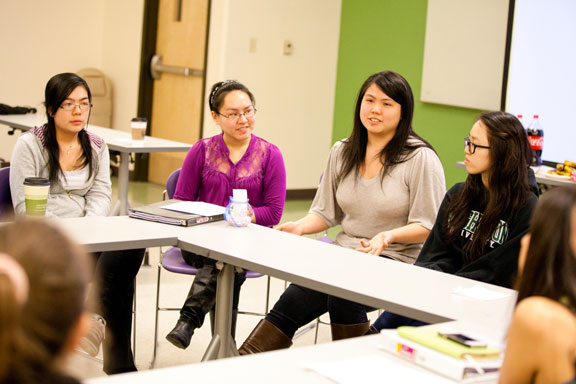
Whether in a job interview or halfway around the world, body language plays a role in interpersonal communication, and two separate workshops Wednesday evening taught students about the messages they send without ever opening their mouths.
The first workshop focused on body language in a professional setting, where student and faculty presenters offered advice to students on how to impress employers and co-workers.
Ann Merriwether, a professor in the psychology department, and Dina Naples-Layish, a professor in the School of Management, spoke about the movements people subconsciously make when they’re under stress, and how they can affect relationships in a professional setting.
“Self touch. Not always as fun as it sounds,” Merriwether said as she flipped through Power Point photographs of celebrities under stress.
One photograph, in particular, showed a woman at a White House meeting.
“So this is Hillary Clinton and she’s self-touching,” Merriwether said. “We talk about facial repetition, but another thing that comforts our brain when we’re stressed is touching ourselves. Sometimes we do it repetitively, like we’ll stroke a body part. And it indicates a high level of stress.”
Parker Levine, an organizer of the event and a freshman majoring in management, suggested students pay closer attention to how they move.
“If [you’re scared], you’re going to move your arms a lot,” Levine said. “If you know you’re going to move back and forth, you can become more aware of that. You can stand more upright, hold your posture stronger, and in the end, lead to a successful interview.”
However, Levine cautioned students against trying to intentionally change certain movements.
“Don’t try to edit your emotions, don’t try to edit your body language, don’t try to wave your hands around to prove a message,” Levine said. “Let your body do the work.”
Merriwether mentioned the significance of micro expressions, small facial distortions that can betray hidden emotions.
“That doesn’t mean we’re lying, we’re trying to conceal all kinds of stuff, and in interviews especially,” she said. “We may be trying to conceal that we’re about to throw up, we’re trying to conceal that we’re really nervous. We’re trying to conceal because our culture has a lot of rules about what we’re allowed to show and what we’re not allowed to show.”
Alec Schnur, a freshman majoring in accounting, said he learned about the practical aspects of body language in the professional world.
“I learned many of the small indicators of poor body language, revealing emotions like disinterest and fear. I found it useful because in the future, I am going to avoid these indicators while presenting,” he wrote in an email to Pipe Dream. “Nobody wants to communicate with one who expresses disinterest, or laziness through body language.”
At the other of the two body language talks, ESL teaching assistants led a discussion among roughly 20 students about differences in body language between countries, genders and individuals.
“In the Middle East, if [you] lift your thumbs up, that’s actually almost like the middle finger,” said Julie Alfonso, an event organizer and a senior majoring in English. “And in the United States if you do a thumbs-up on the side of the road you’re a hitchhiker.”
Some cultural distinctions became obvious when a presenter discussed how American men tend to sit with their legs wide open, while women normally cross their legs. One male student from Korea pointed out that his own legs had been crossed the whole time.
“Am I a woman? You make me so embarrassed,” he said, prompting laughter from other students at the talk.
The event concluded with students playing games in which they had to act out emotions or scenes without sound, while observers tried to guess what they were doing.
Derrick Conyers, a junior majoring in political science, liked the diversity and openness of the event.
“What I liked about this was the fact that there was space for students to talk to students from different nationalities as well as with students who are Americans, so they can get different ideas of what indications mean,” he said.


